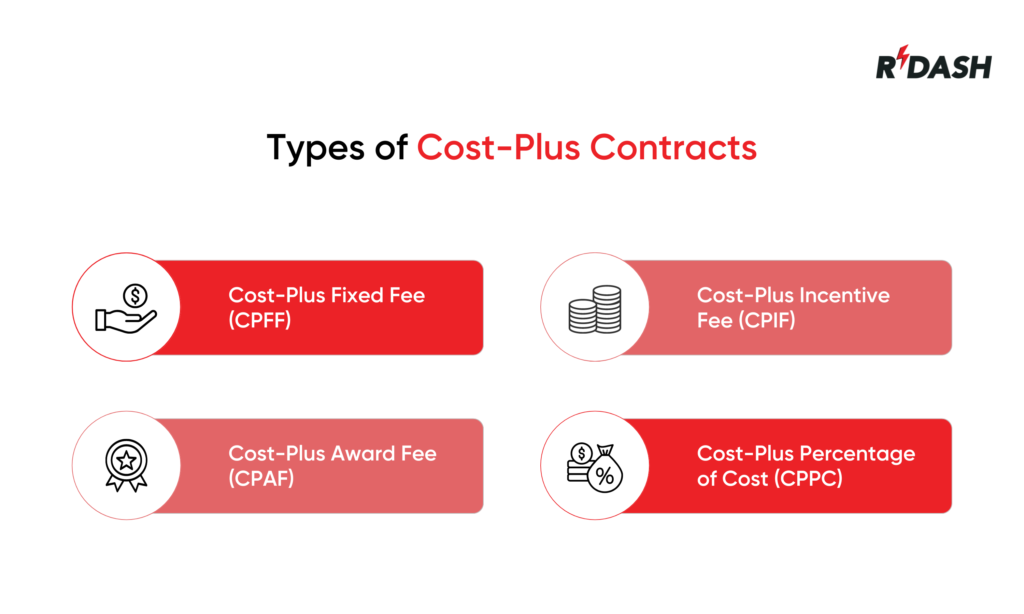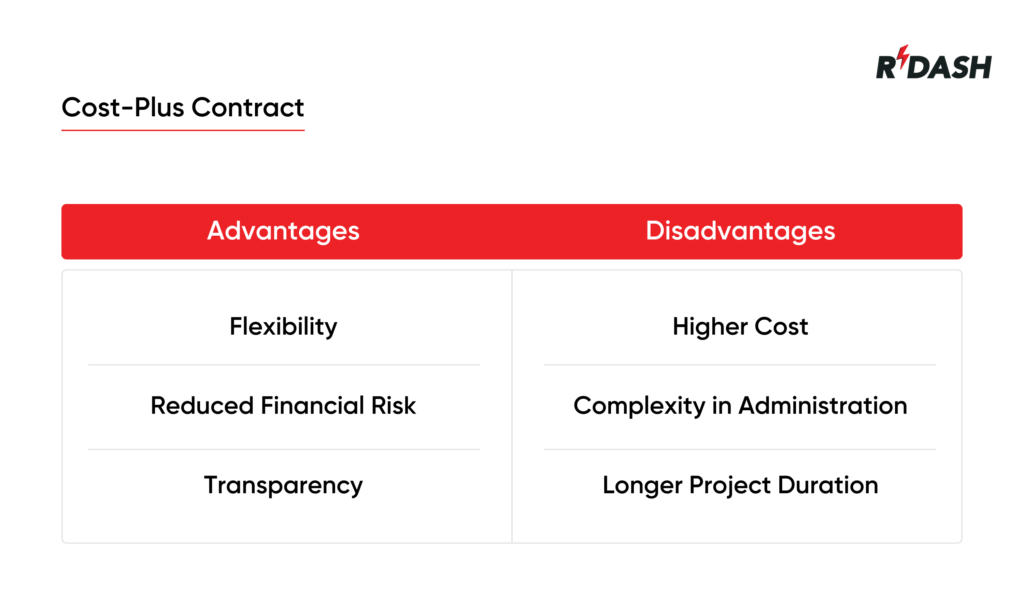What is a cost plus contract?
At its core, a cost-plus contract is pretty straightforward. It’s an agreement where the client agrees to cover the actual costs of the project, plus an additional payment to allow for a profit margin. This type of contract is designed to reduce the risk for contractors, as it ensures that they will be reimbursed for all their expenses, even if those exceed initial estimates.
Types of cost plus contracts
There are several flavours of cost-plus contracts, each suited to different scenarios:
- Cost-Plus Fixed Fee (CPFF): Here, the contractor gets a fixed fee that doesn’t change, regardless of the project duration. This is ideal for projects where the duration is uncertain.
- Cost-Plus Incentive Fee (CPIF): In this arrangement, the contractor can earn an additional incentive fee if they meet specified performance targets. This is great for motivating contractors to stay on schedule and under budget.
- Cost-Plus Award Fee (CPAF): This contract model includes a fixed base fee complemented by a bonus that hinges on the client’s satisfaction with the quality of work delivered by the contractor. It’s subjective but effective for projects requiring high quality standards.
- Cost-Plus Percentage of Cost (CPPC): The contractor’s profit increases if the cost of the project does, making it less common since it provides little incentive for cost control.

When should you use a cost plus contract?
Cost-plus contracts are best utilized when project specifics are hard to nail down before starting, or when tasks are expected to change significantly over time. They are also a good fit in situations where transparent accounting is needed, as they require detailed documentation of all costs.
Here’s why you might choose a cost-plus contract:
- Uncertainty in project scope: If you’re diving into a project with many unknowns, these contracts can provide flexibility to adapt as things change.
- High-risk projects: When the risk of escalating costs is high, a cost-plus contract can ensure that the contractor isn’t left holding the bag if things go over budget.
- Specialized materials or skills: Projects that require specialized expertise or materials, which might be difficult to price out ahead of time, often benefit from this type of contract.
Advantages and disadvantages of cost plus contract
Advantages of using cost plus contracts
Cost-plus contracts are like a safety net for contractors. Here’s why they might be a good choice:
- Flexibility: These contracts are perfect for projects where you can’t nail down all the details upfront. Changes in scope? Unexpected needs? No problem.
- Reduced financial risk: Contractors don’t have to worry about underestimating costs and losing money. They’re covered for actual costs incurred, plus a bit extra.
- Transparency: Since the client covers the costs, there’s typically a requirement for open books, leading to transparent operations and trust-building.
Disadvantages of using cost plus contracts
However, it’s not all smooth sailing. There are a few drawbacks:
- Potential for higher costs: Since contractors know they’ll be reimbursed for all expenses, there’s less incentive to keep costs down, which might lead to a more expensive project overall.
- Complexity in administration: Monitoring costs and ensuring they are legitimate and reasonable can require a lot of oversight, making these contracts administratively heavier.
- Longer project durations: With less pressure to keep costs low, there’s also less incentive to work efficiently, potentially leading to projects that drag on.

Is a cost plus contract right for your project?
Choosing whether to go with a cost plus contract often comes down to the project specifics. They are particularly useful in projects with high uncertainty or those requiring exceptional quality where cost predictability is less important than the outcomes. However, they require careful management and clear terms to ensure that both parties are protected and the project stays on track.
If you’re still uncertain whether a cost-plus contract is the right fit for your project, there are other contract types worth considering. Each option has its own advantages, so exploring these alternatives can help you make a more informed decision.
Example of a cost plus contract
Picture yourself in charge of managing your company’s office renovation in Mumbai. Given that office renovations can uncover unexpected challenges like structural issues or outdated wiring, choosing a cost plus contract could be a prudent decision. Here’s how this could work, step-by-step, using the Indian Rupee as the currency.
Step 1: Selecting the contract type
You and the contractor decide on a Cost Plus Fixed Fee agreement.. This ensures that the contractor’s fee is predetermined and fixed, providing financial predictability for you while accommodating any unforeseen project complexities.
Step 2: Establishing budget and fees
Costs: You agree to cover all essential expenses, such as materials, labor, and other direct costs involved in the renovation.
Fee: The contractor estimates the direct costs at about ₹5 lakh (500,000 INR) and sets a fixed fee of ₹1 lakh (100,000 INR). This fee accounts for their services in project management, procurement, and quality control.
Step 3: Initiating the project
The renovation begins, with the contractor coordinating the procurement of materials and hiring necessary labor. They keep meticulous records of all expenses, from receipts for materials to labor payments.
Step 4: Managing changes
During the renovation, it’s discovered that the air conditioning system is inefficient and needs a complete overhaul—an unplanned but necessary expense that requires additional materials and specialized labor.
Step 5: Monitoring and reporting costs
The contractor provides a detailed weekly report of expenses:
- Initial estimated direct costs: ₹5 lakh
- Additional costs due to AC system upgrade: ₹2 lakh (200,000 INR)
You review and approve these expenses, ensuring they are justified and transparent, offering a clear audit trail of where the funds are going.
Completing the renovation
Upon completion, the total direct costs have increased to ₹7 lakh due to the extra work required. You pay this amount, along with the agreed-upon fixed fee.
Final calculation
Total Costs Paid by You: ₹7 lakh (direct costs) + ₹1 lakh (contractor’s fixed fee) = ₹8 lakh
In this scenario, the cost plus contract allowed you to adapt to unforeseen changes without needing to renegotiate the original terms of the agreement. It provided a level of transparency that helped build trust between you and the contractor, ensuring that you were aware of and agreed upon where every rupee was spent. This contract type proved especially beneficial in managing the complex and unpredictable nature of an office renovation, ensuring that both the quality and scope of the work were maintained without exposing your company to undue financial risk.






